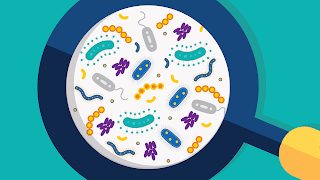The three main types of microbes are bacteria , viruses and microscopic fungi.
1 Bacteria:-
Bacteria are very small living cells with no nucleus. They come in various shapes and sizes. The information needed to control the cell is carried on a single thread of DNA. Bacteria reproduce by dividing into two. In the right conditions , they can reproduce very quickly- about once every 20 minutes.
Viruses are much simpler than bacteria. They are also about 100 times smaller than bacteria so they cannot be seen under an ordinary microscope. Viruses are not cells, they are just a protein shell with some DNA inside. They can only reproduce inside other living cells. They take over a cell and make it produce more viruses.
3 Microscopic fungi:-
These include yeasts and moulds.
Yeast cells seen under a microscope look like tiny balls. They reproduce by growing buds on the side. When the buds are big enough, they drop off.
Moulds grow in warm, damp places. They are made up of lots of thin threads which grow over and inside the food. Moulds feed on dead things. They reproduce by releasing spores into the air.






No comments:
Post a Comment